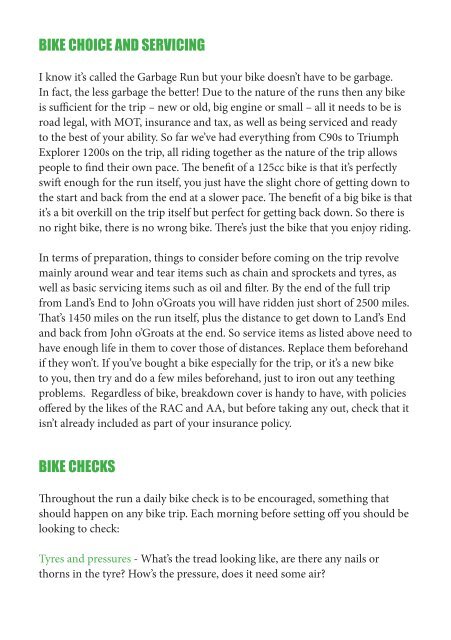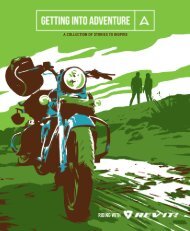You also want an ePaper? Increase the reach of your titles
YUMPU automatically turns print PDFs into web optimized ePapers that Google loves.
BIKE CHOICE AND SERVICING<br />
I know it’s called the <strong>Garbage</strong> <strong>Run</strong> but your bike doesn’t have to be garbage.<br />
In fact, the less garbage the better! Due to the nature of the runs then any bike<br />
is sufficient for the trip – new or old, big engine or small – all it needs to be is<br />
road legal, with MOT, insurance and tax, as well as being serviced and ready<br />
to the best of your ability. So far we’ve had everything from C90s to Triumph<br />
Explorer 1200s on the trip, all riding together as the nature of the trip allows<br />
people to find their own pace. The benefit of a 125cc bike is that it’s perfectly<br />
swift enough for the run itself, you just have the slight chore of getting down to<br />
the start and back from the end at a slower pace. The benefit of a big bike is that<br />
it’s a bit overkill on the trip itself but perfect for getting back down. So there is<br />
no right bike, there is no wrong bike. There’s just the bike that you enjoy riding.<br />
In terms of preparation, things to consider before coming on the trip revolve<br />
mainly around wear and tear items such as chain and sprockets and tyres, as<br />
well as basic servicing items such as oil and filter. By the end of the full trip<br />
from Land’s End to John o’Groats you will have ridden just short of 2500 miles.<br />
That’s 1450 miles on the run itself, plus the distance to get down to Land’s End<br />
and back from John o’Groats at the end. So service items as listed above need to<br />
have enough life in them to cover those of distances. Replace them beforehand<br />
if they won’t. If you’ve bought a bike especially for the trip, or it’s a new bike<br />
to you, then try and do a few miles beforehand, just to iron out any teething<br />
problems. Regardless of bike, breakdown cover is handy to have, with policies<br />
offered by the likes of the RAC and AA, but before taking any out, check that it<br />
isn’t already included as part of your insurance policy.<br />
Chain tension - Is it too tight or too loose? Does it need some adjustment? Part<br />
of your basic tool kit should ideally include the tools needed to nip up your<br />
chain if need be.<br />
Luggage for loose straps and securement - One of the hazards of travelling with<br />
luggage is loose straps and bungees which at worse could either catch in the<br />
wheel or on the exhaust, burning your luggage (I know that one from personal<br />
experience!). Before setting off make sure everything’s tied down and secure.<br />
Oil and fluid levels - Oil level is most crucial, especially on the smaller cc bikes<br />
that can use a good drop or two when held at a steady cruising pace for long<br />
periods of time. Check your levels daily and ideally bring a litre of fresh oil for<br />
top up if your bike does typically get through some.<br />
A general walk around - You’re looking for anything obvious; bolts that might<br />
need tightening, bulbs not working. Are you brakes OK? Does the steering feel<br />
loose? Are your panniers secure? Okay, ready to go.<br />
This will only take 5 minutes but it’s a good way of spotting problems early<br />
and making sure the bike’s fit for the day’s ride ahead!<br />
BIKE CHECKS<br />
Throughout the run a daily bike check is to be encouraged, something that<br />
should happen on any bike trip. Each morning before setting off you should be<br />
looking to check:<br />
Tyres and pressures - What’s the tread looking like, are there any nails or<br />
thorns in the tyre? How’s the pressure, does it need some air?








